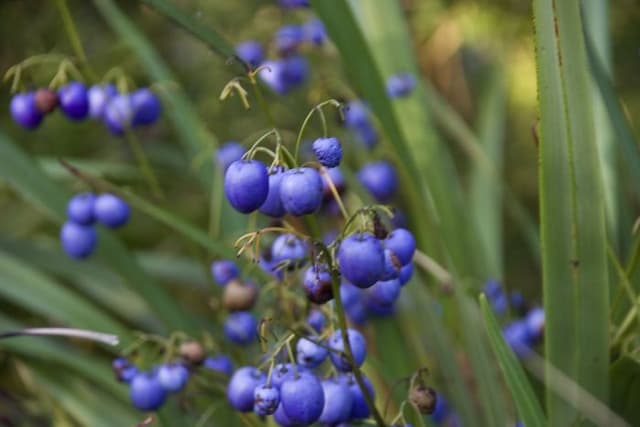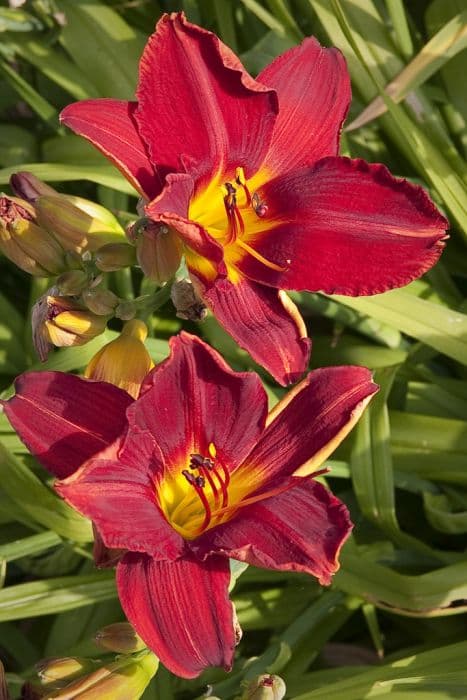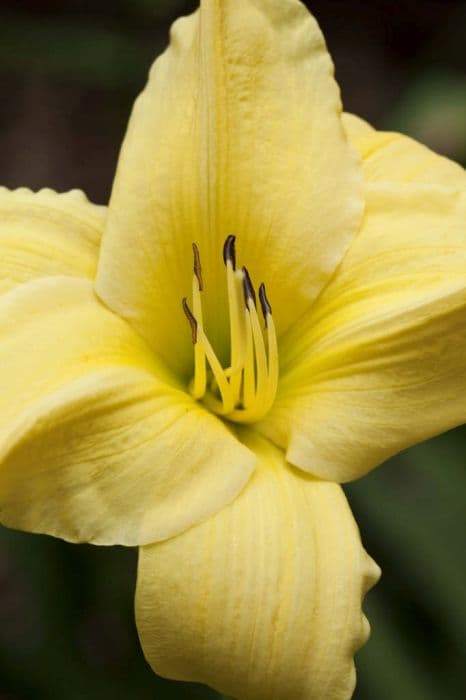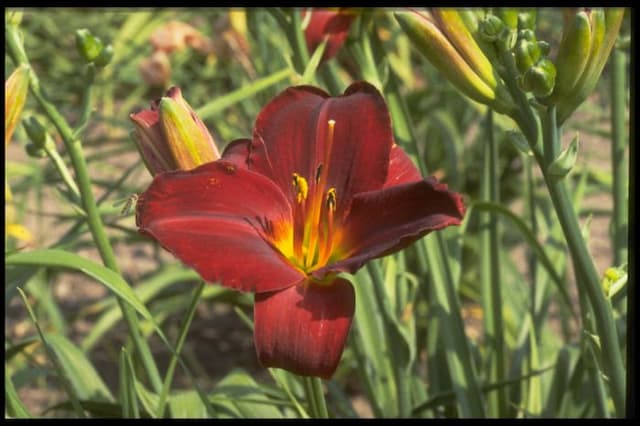Daylily Hemerocallis 'Corky'
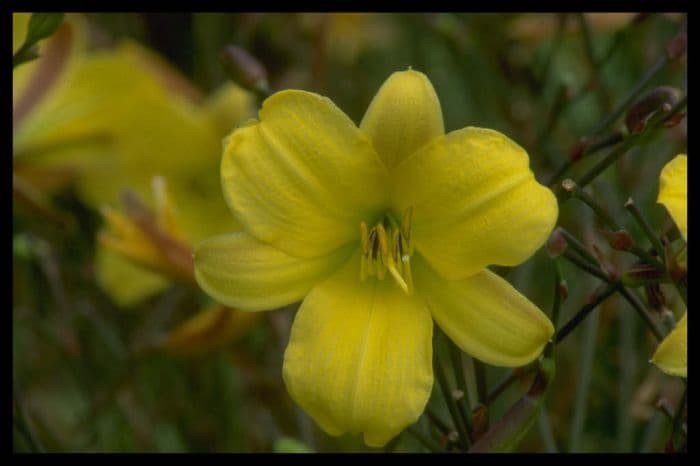
ABOUT
The plant known as Hemerocallis 'Corky' is commonly referred to as the Daylily 'Corky'. This plant is celebrated for its distinctive flower blooms, which have a unique coloration and form. Its flowers display a rich blend of yellow to pale orange petals, resembling the warm hues observed during a sunset. The blossoms may also have a subtle, raspberry-red eye zone that centers around a vibrant greenish-yellow throat, creating a striking contrast that draws attention. These flowers typically display six elongated petals that are somewhat ruffled along the edges, giving them a graceful, yet slightly untamed appearance. Daylily 'Corky' blooms are known to open up during daylight and last for just one day before being replaced by new blooms in a continuous cycle throughout the blooming season. The foliage of this plant consists of long, arching, strap-like leaves that are a deep green color, forming an attractive, lush clump that serves as a backdrop to its remarkable flowers. The plant possesses a robust and hardy nature, making it a popular choice for gardeners who desire a touch of vibrant color without requiring excessive maintenance.
About this plant
 Names
NamesFamily
Hemerocallidaceae
Synonyms
Daylily
Common names
Hemerocallis 'Corky'.
 Toxicity
ToxicityTo humans
The plant commonly known as daylily is not generally considered toxic to humans. In fact, some cultures eat daylily flowers as part of their cuisine. However, it is always best to exercise caution and make sure that any plant is properly identified before consuming it, as individual sensitivities or allergies can cause adverse reactions.
To pets
The daylily is known to be potentially toxic to cats and may cause symptoms if ingested. Symptoms of daylily poisoning in pets, particularly cats, can include vomiting, lethargy, kidney failure, and in severe cases, it may be fatal. It is important to prevent cats from ingesting any part of daylilies. If you suspect your pet has eaten a daylily, you should contact a veterinarian immediately.
 Characteristics
CharacteristicsLife cycle
Perennials
Foliage type
Deciduous
Color of leaves
Green
Flower color
Yellow
Height
2 feet (0.61 meters)
Spread
2 feet (0.61 meters)
Plant type
Herb
Hardiness zones
3
Native area
Asia
Benefits
 General Benefits
General Benefits- Easy to Grow: Hemerocallis 'Corky', commonly known as Daylily 'Corky', is known for being robust and able to thrive in a variety of conditions.
- Drought Tolerant: Once established, it can tolerate periods of dry weather, making it suitable for xeriscaping.
- Attracts Pollinators: The flowers attract butterflies and bees, which can help pollinate other plants in the garden.
- Low Maintenance: Daylilies require minimal care, making them ideal for both beginner and experienced gardeners.
- Pest Resistant: This variety is generally resistant to many pests, reducing the need for chemical treatments.
- Wide Range of Environments: Daylilies can grow in different types of soil and can handle varying amounts of sunlight, from full sun to partial shade.
- Soil Erosion Control: The root system can help stabilize soil and prevent erosion on slopes or in areas prone to heavy rainfall.
- Long Blooming Period: Daylilies have a lengthy blooming season, providing ongoing visual interest in the garden or landscape.
- Edible Parts: Some parts of the Daylily 'Corky' are edible, though they must be consumed with caution due to potential confusion with toxic species.
- Visually Appealing: The unique cork-like texture on the petals of 'Corky' adds an aesthetic value to gardens and landscapes.
 Medical Properties
Medical PropertiesThis plant is not used for medical purposes.
 Air-purifying Qualities
Air-purifying QualitiesThis plant is not specifically known for air purifying qualities.
 Other Uses
Other Uses- As a natural dye source: The petals of the daylily, including Hemerocallis 'Corky', can be used to create a yellow-orange dye for textiles and craft projects.
- In fish farming: The roots and foliage of the daylily can provide shade and shelter for fish in aquacultural systems, promoting a more natural habitat.
- As a compost activator: The green parts of the daylily can help accelerate the decomposition process when added to compost due to their high nitrogen content.
- In mixed flower arrangements: Daylily flowers can add a unique shape and color to floral arrangements, although their individual blooms last only a day.
- As bioindicators: Daylilies can be used to indicate the health of an ecosystem as they respond sensitively to changes in soil and water conditions.
- In art and photography: The daylily's distinctive blooms provide an attractive subject matter for artists and photographers.
- As a natural ground cover: Daylilies can be planted to control erosion and suppress weeds due to their dense growth habit.
- In culinary demonstrations: Daylilies are edible, and the blooms can be used in cooking classes to teach about edible flowers and unconventional ingredients.
- In educational garden programs: Schools and nature centers can use daylilies to teach about plant biology and the lifecycle of perennial plants.
- As an ingredient in homemade potpourri: The dried flowers of daylilies can be included in potpourri mixes for a natural fragrance and splash of color.
Interesting Facts
 Feng Shui
Feng ShuiThe Daylily is not used in Feng Shui practice.
 Zodiac Sign Compitability
Zodiac Sign CompitabilityThe Daylily is not used in astrology practice.
 Plant Symbolism
Plant Symbolism- Daylily ('Corky') - Often symbolizes motherhood and motherly love attributed to its scientific name, Hemerocallis, derived from the Greek words for 'beautiful for a day,' reflecting the fleeting nature of motherhood as children grow up.
- Daylily ('Corky') - Can represent the impermanence and fleeting beauty of life, as each bloom typically lasts only for one day.
- Daylily ('Corky') - In Chinese culture, daylilies are a symbol of forgetfulness or losing one’s memory, this comes from the Chinese name meaning 'forget worry herb'.
- Daylily ('Corky') - Sometimes symbolizes flirtation or coquetry, possibly because of its vibrant colors and the brief duration of its bloom.
 Water
WaterDaylilies, like the Hemerocallis 'Corky', prefer consistently moist soil, especially during the active growing season in spring and summer. Watering should be done deeply and thoroughly, allowing the top inch of soil to dry out slightly between watering sessions. Typically, aim to water daylilies about once a week with approximately 1 to 1.5 inches of water each time, but be prepared to adjust depending on weather conditions, such as increased frequency during hot, dry periods or less during rainy spells. Over the course of a month, this would amount to about 4 to 6 gallons of water per plant, depending on the size of the daylily and local rainfall.
 Light
LightDaylilies, including 'Corky', flourish in full sun to partial shade conditions. They perform best when they receive at least six hours of direct sunlight daily. A spot that offers morning sun with some afternoon shade is ideal to protect them from the intense heat of late afternoon sun. However, 'Corky' is adaptable and can also do well in filtered light conditions, provided it gets enough light to bloom effectively.
 Temperature
TemperatureThe 'Corky' variety of daylilies is hardy and can tolerate a wide range of temperatures, surviving winter lows down to around -20°F and summer highs well above 90°F. However, they grow best in moderate climates where temperatures range between 70°F and 85°F during the growing season. Daylilies are adaptable and will remain dormant during the colder months and revive as temperatures rise in the spring.
 Pruning
PruningPruning daylilies, such as 'Corky', primarily involves deadheading spent blooms and removing dead foliage to encourage more flowers and prevent disease. Pruning can be done throughout the blooming season, as needed. The best time for more significant pruning, such as cutting back dead growth, is in the early spring or after the plant has finished blooming for the season. This not only tidies the plant but also helps conserve its energy for the next growing cycle.
 Cleaning
CleaningAs needed
 Soil
SoilDaylilies prefer well-draining soil that's rich in organic matter; a mix of garden soil, compost, and perlite or sand is ideal. They thrive in a slightly acidic to neutral pH range of 6 to 7.
 Repotting
RepottingDaylilies, including the 'Corky', typically do not need frequent repotting and are often planted directly in the ground. If grown in containers, repot every 3 to 4 years.
 Humidity & Misting
Humidity & MistingDaylilies are adaptable but prefer moderate humidity levels; they do not require high humidity environments to thrive.
 Suitable locations
Suitable locationsIndoor
Ensure bright light and pot in well-draining soil.
Outdoor
Plant in full sun to part shade in fertile soil.
Hardiness zone
3-9 USDA
 Life cycle
Life cycleThe life of the Daylily 'Corky' typically begins with seed germination, which occurs when the conditions of warmth and moisture are favorable, leading to the emergence of a small shoot and root system. After germination, the plant enters a vegetative growth stage, where it develops a clump of strap-like foliage and an extensive root system that helps it survive periods of drought. As it matures, 'Corky' reaches a stage of flowering, generally in late spring to early summer, where it produces unique, trumpet-shaped flowers that are often a blend of yellow and copper tones, each bloom lasting just one day. After pollination, which may be facilitated by insects, 'Corky' can produce seeds in a capsule, although many gardeners propagate it through division of the clumps every few years to maintain vigor. Once the flowering season is over, the plant enters a period of dormancy during colder months, especially in regions with harsh winters, where the foliage dies back and the plant conserves energy within its root system. In the following growing season, the cycle begins anew with fresh growth from the crown, continuing its perennial life cycle.
 Propogation
PropogationPropogation time
Late Summer to Early Fall
Hemerocallis 'Corky', commonly known as the daylily, is generally best propagated through division, which is the most popular method for this perennial plant. Division should ideally be performed in the early spring or after the blooming period in late summer to early fall. To propagate through division, a gardener should dig up an established clump of daylilies and gently pull the fans, or individual plant segments with leaves and roots, apart. Each fan should have a good set of roots and at least two or three leaves. These individual fans can be planted directly into a well-prepared garden bed or pot, ensuring the crown is set at about one inch below the surface of the soil. Once planted, watering should be done thoroughly to help establish the newly divided plants.
